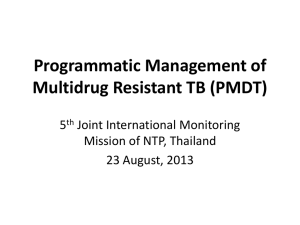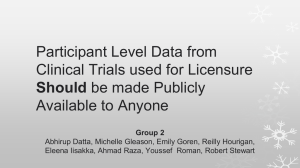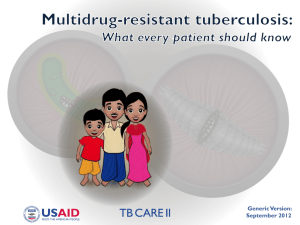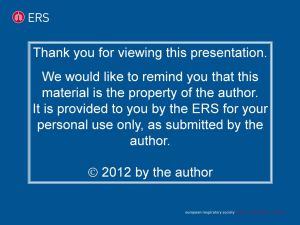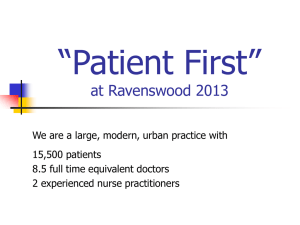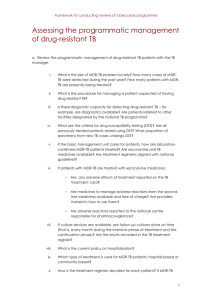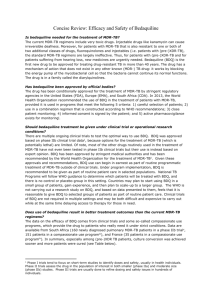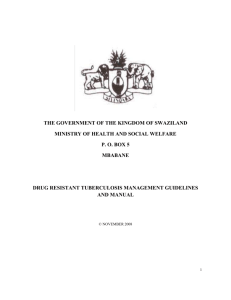GLOBAL TB
advertisement
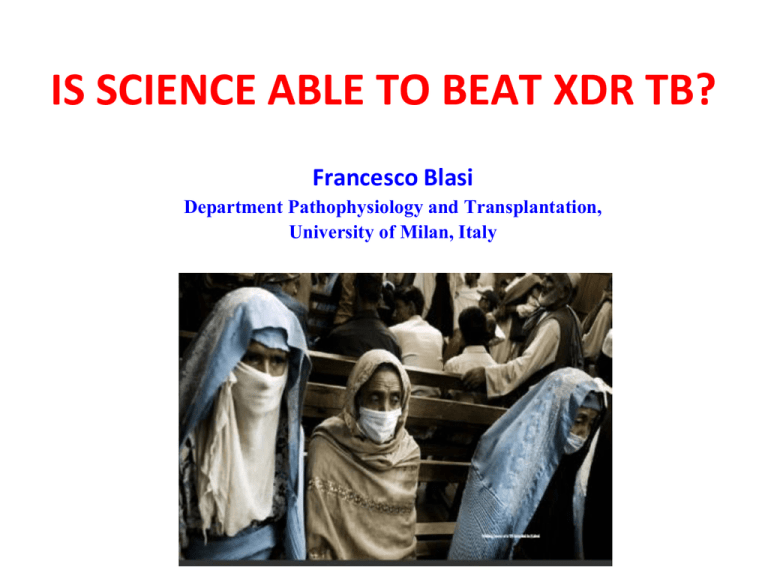
IS SCIENCE ABLE TO BEAT XDR TB? Francesco Blasi Department Pathophysiology and Transplantation, University of Milan, Italy Disclosures • I have accepted grants, speaking and conference invitations from Almirall, Angelini, AstraZeneca, Bayer, Chiesi, GSK, Guidotti-Malesci, Menarini, Novartis, Pfizer, and Zambon • I have had recent or ongoing consultancy with Almirall, Angelini, AstraZeneca, GSK, Menarini, Mundipharma and Novartis 92 countries notified at least one case of XDR-TB Ref: Global TB Control Report 2013 GLOBAL TB PROGRAMME Proposed Vision A WORLD FREE OF TB ZERO TB DEATHS ZERO TB CASES ZERO TB SUFFERING GLOBAL TB PROGRAMME Proposed Goal and Targets GOAL: End the Global TB Epidemic 2035 Target 1 95% reduction in TB deaths (compared with 2015) Target 2 <10/100 000 TB incidence rate GLOBAL TB PROGRAMME Getting there: Milestones 2020 TARGETS 2025 2030 2035 GOAL TARGETS TARGETS • 35% reduction in TB deaths • 75% reduction in TB deaths • 90% reduction in TB deaths • 95% reduction in TB deaths • <85/100 000 TB incidence rate • <55/100 000 TB incidence rate • <20/100 000 TB incidence rate • <10/100 000 TB incidence rate • No affected families with catastrophic costs due to TB • No affected families with catastrophic costs due to TB • No affected families with catastrophic costs due to TB • No affected families with catastrophic costs due to TB GLOBAL TB PROGRAMME Post-2015 TB Strategy Proposed Pillars and Principles Highquality, integrated TB care and prevention GLOBAL TB PROGRAMME Bold policies and supportive systems Intensified research and innovation Post-2015 TB Strategy: Pillar 1 Highquality, Early diagnosis of TB integrated including universal TB care and drug susceptibility prevention testing; systematic 2 1 screening of contacts and high-risk groups Preventive treatment of people at high-risk and vaccination for TB GLOBAL TB PROGRAMME GLOBAL TB PROGRAMME 4 3 Treatment of all people with TB including drug-resistant TB, with patient-centered support Collaborative TB/HIV activities and management of co-morbidities Post-2015 Global TB Strategy Proposed Pillars Targets: 95% reduction in deaths and 90% reduction in incidence (< 10 cases / 100,000 population) by 2035 Integrated, patientcentered TB Care and Prevention Early diagnosis of TB including universal drug-susceptibility testing ; systematic screening of contacts and high-risk groups Treatment of all people with TB including drug -resistant TB; and patient support Collaborative TB/HIV activities and management of co-morbidities Preventive treatment for persons at high-risk; and vaccination against tuberculosis GLOBAL TB PROGRAMME Bold policies and supportive systems Political commitment with adequate resources for TB care and prevention Engagement of communities , civil society organizations, and all public and private care providers Universal health coverage policy; and regulatory framework for case notification, vital registration, quality and rational use of medicines, and infection control Social protection, poverty alleviation, and actions on other determinants of TB Intensified Research and Innovation Discovery, development and rapid uptake of new tools, interventions and strategies Research to optimize implementation and impact, and promote innovations What is needed to accelerate incidence decline and target "elimination"? Economic development: better nutrition & housing Universal health coverage & social protection TB care widely accessible to all and of high-standards Focused, high-intensity interventions, including BCG in children Screening of high-risk groups and mass TLTBI Infection control practices However… while incidence decline can accelerate, “elimination” is another story, as it requires major reduction of: (i) transmission rate, and (ii) reactivation of latent infection among the already infected In turn, this requires…new tools and increased financing What is in the pipelines for new diagnostics, drugs and vaccines in 2013? Diagnostics: ₋7 new diagnostics or diagnostic endorsed by WHO since 2007; ₋6 in development; ₋yet no PoC test envisaged methods Drugs: -2 new drugs approved in 2012 & 2013 for MDR-TB : little impact on epidemiology; -a regimen and other 2-3 drugs likely to be introduced in the next 4-7 years Vaccines: ₋11 vaccines in advanced phases of ₋development; ₋1 reported in 2012 with no detectable efficacy Diagnostic development pipeline, 2013 Liquid culture + DST Rapid speciation LPA for MDR-TB Non-commercial culture + DST LPA for XDR-TB LPA for MDR-TB, 2nd generation REFERENCE LEVEL Rapid colorimetric DST 2-specimen approaches Xpert MTB/RIF LED microscopy INTERMEDIATE LEVEL Xpert 2nd generation Manual NAAT VOC detection Enzymatic detection Ag and Ab detection NAAT 2nd generation PERIPHERAL LEVEL 2007 2008 2009 2010 2011 2012 2013 2014 2015 7 new diagnostics or diagnostic methods approved by WHO since 2007 3 diagnostics commercially available, not yet WHO-endorsed 6 diagnostics in development GLOBAL TB PROGRAMME Source: Stop TB Partnership Working Group on New TB Diagnostics 2016 Gene Xpert Progress in the roll-out of Xpert MTB/RIF, by July 2013 Ref: Global TB Control Report 2013 GLOBAL TB PROGRAMME ulture and DST laboratories to diagnose MDR-TB, 2010 20/36 HBCs* have insufficient capacity to diagnose MDR-TB Culture and DST laboratories to diagnose MDR-TB, 2010 Laboratories per 5M population ≥1 ≥1 Culture and DST <1 <1 laboratories per 5M, 2010 *HBC= high-burden country NA Countries = Afghanistan, Armenia, Azerbaijan, Bangladesh, Belarus, Brazil, Bulgaria, Cambodia, China, DR Congo, Estonia, Ethiopia, Georgia, India, Indonesia, Kazakhstan, Kenya, Kyrgyzstan, Latvia, Lithuania, Mozambique, Myanmar, Nigeria, Pakistan, Philippines, Republic of Moldova, Russian Federation, South Africa, Tajikistan, Tanzania, Thailand, Uganda, Ukraine, Uzbekistan, Viet Nam, Zimbabwe Tools required for eradication in our lifetime – Vaccines : Perspectives for a potent vaccine Mass vaccination with a potent vaccine: – pre-exposure: would prevent infection to occur, and therefore disease, but impact would take a long time to appear – post-exposure: would prevent “reactivation”, and would have impact on transmission as new cases will not emerge any longer out of the pool of already infected. However, it would not prevent new infection GLOBAL TB PROGRAMME Global TB Vaccine Pipeline 2014: good but needs to keep growing Phase II Ad5 Ag85A McMaster CanSino ID93 + GLA-SE IDRI, Aeras Hyvac 4/ AERAS-404 + IC31 SSI, sanofi-pasteur, Aeras, Intercell H56 + IC31 SSI, Aeras, Intercell MTBVAC TBVI, Zaragoza, Biofabri Hybrid-I + CAF01 SSI, TBVI GLOBAL TB PROGRAMME VPM 1002 Max Planck, VPM, TBVI Hybrid-I + IC31 SSI, TBVI, EDCTP, Intercell RUTI Archivel Farma, S.L Phase IIb Phase III MVA85A/AERAS485 OETC, Aeras AERAS-402/ Crucell Ad35 Crucell, Aeras M72 + AS01 GSK, Aeras M. Vaccae Anhui Longcom, China Viral vector rBCG Protein/adjuvant Attenuated M.tb Immunotherapeutic: Mycobacterial – whole cell or extract 17 BCG evidence and MVA85A phase 2b trial results • BCG: efficacy in disseminated pediatric forms proven. Efficacy against adult Reality check about vaccines contagious forms variable. Revaccination efficacy nihil or dubious • MVA85A: 1.Today we do not have a potent pre- and postexposure vaccine, we have BCG 2.Today we do not have yet clarity about correlates of immunity and bio-markers 3.Today, we do not fully understand Safe pathogenesis and immunity Showing it is feasible to test vaccine candidates in large trials, but… No detectable efficacy GLOBAL TB PROGRAMME Latest recommendations for MDR-TB treatment – 2011 A fluoroquinolone, preferably later-generation, and ethionamide should be used 4 second-line drugs likely to be effective including a parenteral agent and pyrazinamide should be used in the intensive phase Regimens should include at least pyrazinamide, a FQ, a parenteral agent, ethionamide (or prothionamide), and either cycloserine or PAS (p-aminosalicylic acid) if cycloserine cannot be used Duration: at least 8 months for the intensive phase and at least 20 months in total Evidence: meta-analysis of >9000 individual MDR-TB patient data from 32 published observational studies, none being randomised controlled trials (RCTs) Management of Patients With Documented or Strongly Suspected XDR-TB – Harrison’s Principles of Internal Medicine 1. Use pyrazinamide and any first-line oral agents that may be effective. 2. Use an injectable agent to which the strain is susceptible, and consider an extended duration of use (12 months or possibly the whole treatment period). If the strain is resistant to all injectable agents; a use of one that the patient has not previously received is recommended. 3. Use a later-generation fluoroquinolone, such as moxifloxacin, levofloxacin or, possibly, gatifloxacin. 4. Use all second-line oral bacteriostatic agents (para-aminosalicylic acid, cycloserine, and ethionamide or prothionamide) that have not been used extensively in a previous regimen or that are likely to be effective. b 5. Add bedaquiline and one or more of the following drugs : clofazimine, linezolid, amoxicillin/clavulanic acid, clarithromycin, and carbapenems such as imipenem/cilastatin and meropenem. If bedaquiline is not available, add linezolid plus two or more from the same list of drugs. Monitor patients closely for linezolid-induced side effects such as myelosuppression and peripheral neuropathy. 6. The introduction of delamanid into clinical use will provide further options. The association with bedaquiline is, however, not recommended at the moment in view of the current lack of information on potential additive cardiac toxicity. 7. Consider treatment with high-dose isoniazid if low-level resistance to this drug is documented. 8. Consider adjuvant surgery if there is localized disease. 9. Enforce strong infection-control measures. 10. Implement strict directly observed therapy and full adherence support as well as comprehensive bacteriologic and clinical monitoring. Reality check about treatment and chemoprophylaxis 1. Today we do not have a potent treatment regimen that lasts <2 months and treats TB and M/XDR-TB. It will probably not be available for at least 5-10 years 2. Today we do have a treatment for latent TB infection that is 70% efficacious, but difficult to scale-up to whole population (? 2 billion infected) or even to high-risk groups 3. Today we do not have a test capable of identifying who will progress to active TB among the ?2 billion infected GLOBAL TB PROGRAMME Re-purposed Drugs: A potent regimen for treatment Assessment of fluoroquinolone trials in early 2014 Three trials: OFLOTUB/Gatifloxacin for TB Phase III trial: gatifloxacin substituted for ethambutol – 4 months Rx - results in late 2013 failed to show non-inferiority. However, gatifloxacin was safe ReMox: moxifloxacin substituted for ethambutol or isoniazid – 4 months Rx - results expected early 2014 Rifaquin trial: moxifloxacin substituted for ethambutol (intensive phase), associated with rifapentine once weekly in continuation phase – presentation at CROI 2013. 4-month arm did not work Novel regimens investigated by the TB Alliance including: PA824, Moxi, PZA, BDQ, CLO in various combinations (NC-001, NC-002, NC-003) GLOBAL TB PROGRAMME GLOBAL TB PROGRAMME Bedaquiline Delamanid 25 Building an MDR-TB Regimen Delamanid DELAMANID Delamanid added to a background MDR-TB regimen improves significantly SS-C conversion at month 2 (45.4 vs 29.6%) 35 ERS PHARMA EVENT - ROME A symposium was organized by ERS with the participation of supranational agencies such as WHO and ECDC. The aim of the event was to bring together industry and key TB stakeholders to discuss and agree on common principles of rational introduction and responsible use of new TB tools. ERS/WHO Consilium for M/XDR-TB Objectives: To allow a European clinician, free cost, to load patient’s data and receive in 1 working day suggestions by 2 experts on how to manage a difficult-to treat TB case To support follow-up of TB patients travelling within Europe Web-based regional platform Specialized team able to cover several perspectives:(clinical for both adults and children, surgical, radiological, public health, psychological, nursing, etc. Managed by ERS, in collaboration with WHO Europe (formal agreement) and ECDC E-platform Now operational at www.tbconsilium.org • >50 International Experts selected by ERS/WHO/ECDC panel • Legal issues tackled according to Swiss and European regulations • Available in : English, Spanish, Portuguese and Russian •Transborder migration component under development Description of the innovative platform Doctor, survivor, psychologist, nurse, microbiologist, rehab AC asks for modification (Co-)Director ask for modification Director Doctor Doctor submits the case Area Coordinator Co-Director EU AC allocates to 2 experts Expert #1 Expert #1 submits his report Area Coordinator Expert #2 One of the 2 directors either ask for more info, or allocate to an AC. Both directors have the same rights (but 2 different accounts). Validated by AC, report available Expert #2 submits his report AC asks for modification WHO National Representative Doctor Patient Eastern European doctor Doctor The platform principles: Case creation • Any physician can create an account and submit a case, through a 10 steps web form • Estimated time: 20-45 min. Upload of pictures, scans, etc possible. The platform principles: Case creation The platform principles: dashboards (example in Russian) www.tbconsilium.org The platform principles: Trans-border cases • As of today, the system is limited to the creation of a case and selection of a National TB Project Representative in the country the patient is moving to. Doctor Selection of the country Selection of the NTPR NTPR • The NTPR immediately receives the case in PDF, by Email Cross border use cases 1. Find the clinician who originally treated the patient: Treating clinician 1. Creates short form NTPM 2. Allocate the case to original clinician Original clinician 3. Fills the full form for the treating clinician 2. Find a clinician to take care of a home country returning patient Source clinician 1. Creates short form NTPM 3. Fills the full form for the receiving clinician 4. Inform NTPM / Local authorities of a migrating patient relatives Treating clinician 1. Creates short form, including names NTPM 2. Allocate the case to original clinician Receiving clinician THANK YOU FOR YOUR ATTENTION

